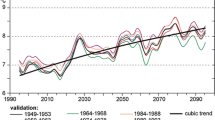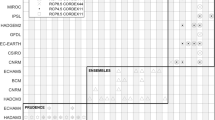Abstract
The urge for higher resolution climate change scenarios has been widely recognized, particularly for conducting impact assessment studies. Statistical downscaling methods have shown to be very convenient for this task, mainly because of their lower computational requirements in comparison with nested limited-area regional models or very high resolution Atmosphere–ocean General Circulation Models. Nevertheless, although some of the limitations of statistical downscaling methods are widely known and have been discussed in the literature, in this paper it is argued that the current approach for statistical downscaling does not guard against misspecified statistical models and that the occurrence of spurious results is likely if the assumptions of the underlying probabilistic model are not satisfied. In this case, the physics included in climate change scenarios obtained by general circulation models, could be replaced by spatial patterns and magnitudes produced by statistically inadequate models. Illustrative examples are provided for monthly temperature for a region encompassing Mexico and part of the United States. It is found that the assumptions of the probabilistic models do not hold for about 70 % of the gridpoints, parameter instability and temporal dependence being the most common problems. As our examples reveal, automated statistical downscaling “black-box” models are to be considered as highly prone to produce misleading results. It is shown that the Probabilistic Reduction approach can be incorporated as a complete and internally consistent framework for securing the statistical adequacy of the downscaling models and for guiding the respecification process, in a way that prevents the lack of empirical validity that affects current methods.



Similar content being viewed by others
Notes
Under Duhemian ambiguity there is no formal way to discriminate if a statistical model is inadequate because its probabilistic assumptions are violated or because the substantive information supporting the model is incorrect.
Note that the arguments that follow are equally valid for other goodness of fit measures as well as for error metrics such as the Root Mean Square Error (RMSE).
References
Anderson TW, Darling DA (1952) Asymptotic theory of certain “goodness-of-fit” criteria based on stochastic processes. Ann Math Stat 23:193–212
Andreou A, Spanos A (2003) Statistical adequacy and the testing of trend versus difference stationary. Econometric Rev 22:217–237
Andrews DWK, Ploberger W (1994) Optimal tests when a nuisance parameter is present only under the alternative. Econometrica 62(6):1383–1414
Benestad RE, Hanssen-Bauer I, Chen D (2008) Empirical-statistical downscaling. World Scientific Publishing Company
Breusch TS (1979) Testing for autocorrelation in dynamic linear models. Aust Econ Paper 17:334–355
Brock W, Dechert D, Sheinkman J, LeBaron B (1996) A test for independence based on the correlation dimension. Economet Rev 15(3):197–235
Christensen JH, Carter TR, Rummukainen M, Amanatidis G (2007) Evaluating the performance of regional climate models: the PRUDENCE project. Clim Change 81(1):1–6
Engle RF (1982) Autoregressive conditional heteroskedasticity with estimates of the variance of U.K. inflation. Econometrica 50:987–1008
Fowler HJ, Blenkinsop S, Tebaldi C (2007) Linking climate change modelling to impacts studies: recent advances in downscaling techniques for hydrological modelling. Int J Climatol 27:1547–1578
Gay C, Estrada F, Sanchez A (2009) Global and hemispheric temperature revisited. Clim Change 94:333–349
Godfrey LG (1978) Testing against general autoregressive and moving average error models when the regressors include lagged dependent variables. Econometrica 46:1293–1302
Goodess CM (2005) STAtistical and regional dynamical downscaling of EXtremes for European regions (STARDEX). http://www.cru.uea.ac.uk/projects/stardex/reports/STARDEX_MR7_2005_section_6.pdf
Granger CWJ, Newbold P (1974) Spurious regression in econometrics. J Econometrics 2:111–120
Greene WH (2002) Econometric Analysis. Prentice Hall
IPCC (2007) In: Solomon S, Qin D, Manning M, Chen Z, Marquis M, Averyt KB, Tignor M, Miller HL (eds) Climate change 2007: the physical science basis. Contribution of working group I to the fourth assessment report of the intergovernmental panel on climate change. Cambridge University Press, Cambridge
Jacob D, Christensen OB, Doblas-Reyes FJ, Goodess C, Tank AK, Lorenz P, Roeckner E (2008) Information on observations, global and regional modeling data availability and statistical downscaling. ENSEMBLES Tech Rep No 4
Jarque CM, Bera AK (1980) Efficient tests for normality, homoscedasticity and serial independence of regression residuals. Econ Lett 6(3):255–259
Klein WH, Lewis BM, Enger I (1959) Objective prediction of five-day mean temperature during winter. J Meteor 16:672–682
Ljung GM, Box GEP (1978) On a measure of lack of fit in time series models. Biometrika 65:297–303
McLeod AI, Li WK (1983) Diagnostic checking ARMA time series models using squared residual autocorrelations. J Time Ser Anal 4:269–273
Mitchell TD, Jones PD (2005) An improved method of constructing a database of monthly climate observations and associated high-resolution grids. Int J Climatol 25:693–712
Ramsey JB (1969) Tests for specification errors in classical linear least squares regression analysis. J Roy Stat Soc B 31:350–371
Spak S, Holloway T, Lynn B, Goldberg R (2007) A comparison of statistical and dynamical downscaling for surface temperature in North America. J Geophys Res 112, D08101
Spanos A (1986) Statistical foundations of econometric modelling. Cambridge University Press, Cambridge
Spanos A (1995) On normality and the linear regression model. Economet Rev 4(2):195–203
Spanos A (2006) Revisiting the omitted variables argument: substantive vs. statistical adequacy. J Econ Meth 13:179–218
Spanos A (2010) Statistical adequacy and the trustworthiness of empirical evidence: statistical vs. substantive information. Econ Model 27:1436–1452
Spanos A, Mcguirk A (2002) Where do statistical models come from? The problem of specification uncertainty in empirical modeling. Virginia Tech. Available at http://www.econ.ucy.ac.cy/seminars/Spanos.pdf
von Storch H, Hewitson B, Mearns L (2000) Review of empirical downscaling techniques. In: Iversen T, Høiskar BAK (eds) Regional climate development under global warming. General technical report 4
White H (1980) A heteroskedasticity-consistent covariance matrix estimator and a direct test for heteroskedasticity. Econometrica 48(4):817–838
Wilby RL, Dawson CW, Barrow EM (2002) SDSM—a decision support tool for the assessment of regional climate change impacts. Environ Modell Softw 17(2):145–157
Wilby RL, Charles SP, Zorita E, Timbal B, Whetton P, Mearns LO (2004) Guidelines for use of climate scenarios development from statistical downscaling methods. Available at http://www.narccap.ucar.edu/doc/tgica-guidance-2004.pdf
Yule GU (1926) Why do we sometimes get nonsense-correlations between time-series?-A study in sampling and the nature of time-series. J Roy Stat Soc 89:1–63
Author information
Authors and Affiliations
Corresponding author
Electronic supplementary material
Below is the link to the electronic supplementary material.
ESM 1
(DOC 5526 kb)
Rights and permissions
About this article
Cite this article
Estrada, F., Guerrero, V.M., Gay-García, C. et al. A cautionary note on automated statistical downscaling methods for climate change. Climatic Change 120, 263–276 (2013). https://doi.org/10.1007/s10584-013-0791-7
Received:
Accepted:
Published:
Issue Date:
DOI: https://doi.org/10.1007/s10584-013-0791-7




